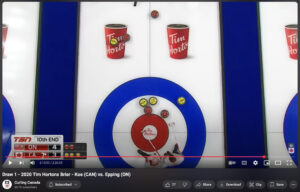Strategy and Tactics

Book review: What’s your Call?
This delightful book, published in October 2022, is a collaboration between Scotland’s Doug Wilson and long-time Alberta skip (and Curling Alberta board member) Mickey Pendergast. In addition to the book, Doug runs the Daily Curling Puzzle group on Facebook, which boasts 23.5k members and offers frequent strategy puzzles for education and comment. What’s Your Call is a unique book in that it couples a particular on-ice scenario from an actual competitive game with a video clip that shows the setup and then the actual shot attempted by that particular team in that game. For the most part, game scenarios are taken from Canadian Season of Champions games so as to avoid geo-blocking from World Curling events. The book contains 50 such real-life scenarios. Unlike many older volumes on strategy, the scenarios are taken from a variety of fairly recent matches and so the 5-rock FGZ rule is in effect (but alas, not the more recent “No-Tick” rule change adopted this
Book review: A Pane in the Glass
Bill Tschirhart has been involved in coaching the sport of curling for many years. I was first introduced to Bill in 1990 when he was coach of the University of Waterloo varsity curling teams, which was Bill’s first coaching position. Since then, Bill has held coaching positions provincially and nationally, coached at both national and international events, and at one time was Curling Canada’s national development coach at Curling Canada’s National Training Centre (NTC) in Calgary. Over the years Bill has published a number of articles about coaching the sport of curling, both in print media and on the web, and in addition launched an online blog a few years ago. Today, Bill can be found on the airwaves with his Pane in the Glass Podcast, which can be found through most podcast channels including Apple. Contents The short essays in A Pane in the Glass are grouped by topic: Coaching, Technical, Team Dynamics, Strategy, Physical Preparation and Nutrition, Mental
Tac-tic-tee by Rock Science
Tac-Tic-Tee (Tactic-Tee, not Tic-Tac-Tee) is a curling strategy game that centers on shot selection. Players of the game pretend that they are skipping a team in their club championship final. A play situation involves the layout of the stones as diagrammed on one of the rock-position cards, supplemented by the specific circumstances for the shot: which colour is your team throwing, which end is it, which player is throwing, how keen and/or straight is the ice, what is the score, what the are abilities of your teammates, and so on. With each situation, and given the stones in play, you then select from a list the best possible shot to call. Once the shot is selected, the scenario booklet lists the potential choices, an analysis of each potential shot, along with a score. If you selected the “correct” shot, you earn 100 points, whereas with a disastrous call you will lose 100 points, with other choices in-between. After a certain
Shot selection and strategy
Strategy and tactics are two terms often used to describe the choices that a team can make during an end, or during a game. Former National Training Centre coach Bill Tschirhart describes strategy this way: Strategy is the shot called after considering a variety of factors in light of a pre-determined game plan which results from an overall philosophy. Tactics, on the other hand, relate to the factors that determine the outcome of the particular shot: What turn do we play? What weight do we play? How much ice do we take? How does our sweeping effect this shot? How does the specific player affect this shot? Strategy and tactics are inter-related; they represent a continuum of choices from the high-level (how does our team want to control the last two ends of play?) to the low-level (precisely how do we place the broom so that we can make this double-takeout?). Paul Webster, the current National Training Centre coach for
Understanding the Free Guard Zone rule
During Bantam practice yesterday, a number of situations arose where properly utilizing the Free Guard Zone would change both the strategy of play and the tactics used at the beginning of the end. So here’s a brief explanation of the Free Guard Zone rule, re-printed here from the Elmira and District Curling Club website. The Free Guard Zone (FGZ) rule was invented to encourage more aggressive play by ensuring that, if a team desires, a lead’s two stones could be in play (and not removed by the opposing team) at the beginning of each end. The FGZ can be used effectively by a team without last rock to place guards on or near the center line, in front of the rings, that can be used to promote or draw behind. Free Guard Zone Defined The free guard zone is the area between the hog line and the tee line, excluding the house. A rock that comes to rest past the
Which shot is more difficult?
At the beginning of October I had the privilege of participating in the Team Glenn Howard Fantasy Camp. Not only did we get the opportunity to learn from Glenn and his team, but they also brought in a number of National-level coaches including Bill Tschirhart, Wendy Morgan, Jim Waite, Earle Morris, Scott Taylor, Brian Savill (Craig’s father) and Jennifer Jones. During the camp I learned a number of new drills, coaching tips, and a wealth of new material about the game, and I will be using some of these new techniques during this season and posting about them in this forum. This first post is about shot difficulty. I can recall my own father who claimed many times that the hardest shot in curling was a guard – but my Dad played in the 1940’s and 1950’s, usually on less than an ideal ice surface (natural ice in rural Saskatchewan) and, of course, using corn brooms. As a skip, one